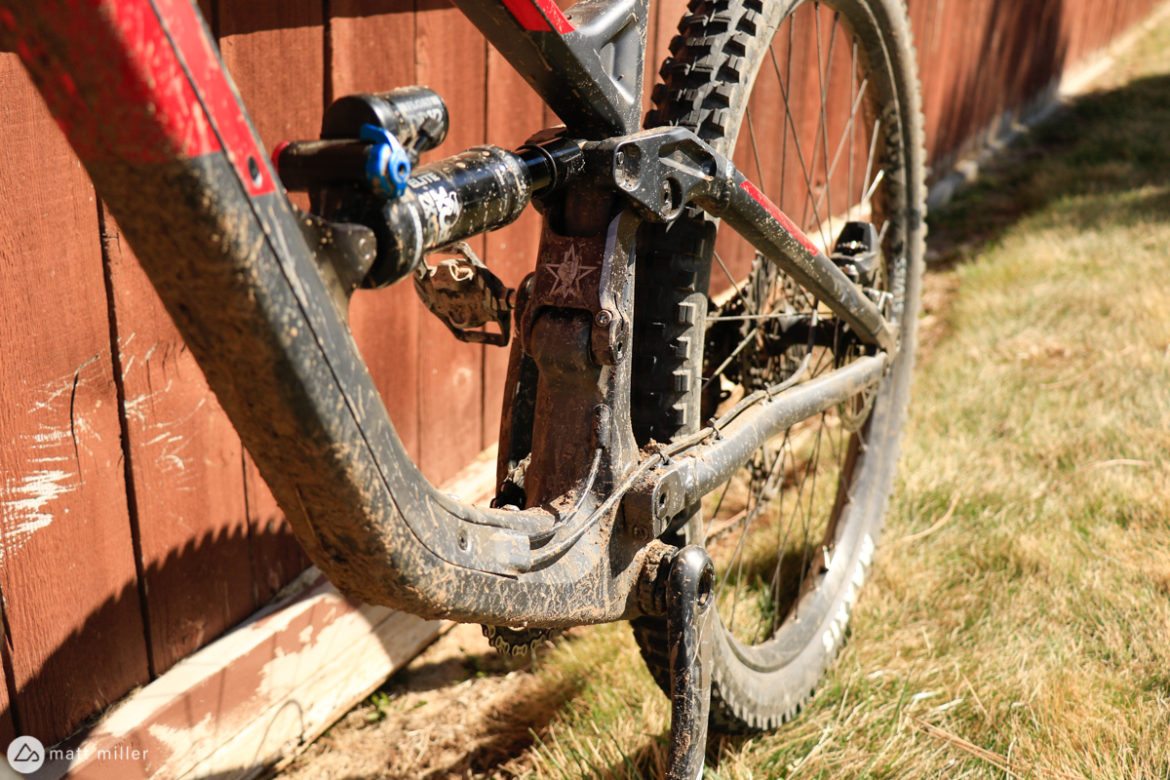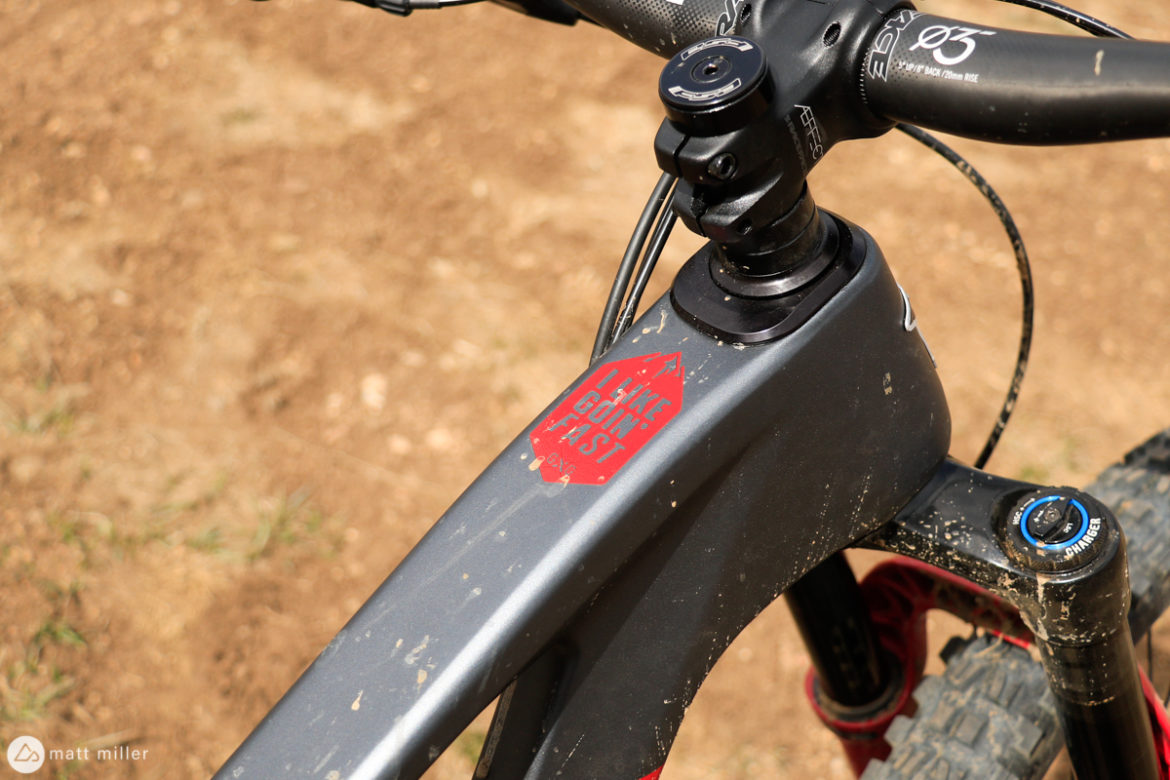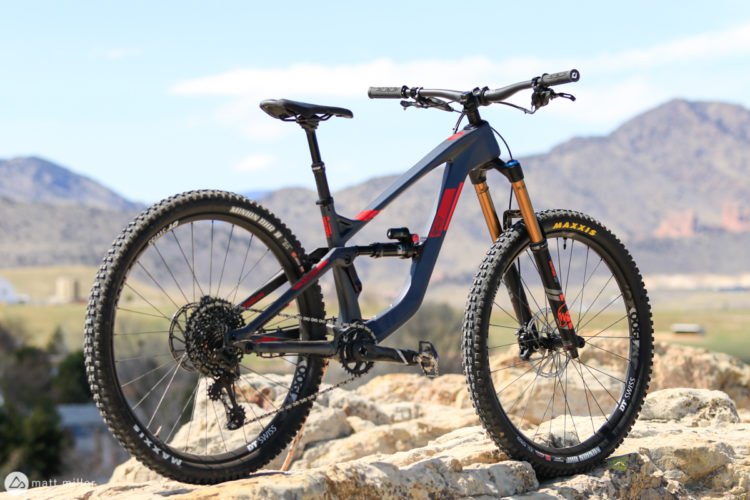
As the name implies, the Guerrilla Gravity ‘The Smash’ sounds like a hammer of a bike, bringing visions of the Hulk, or Gallagher to mind, or maybe fast tires punishing rock below them. It’s actually a clever ode to the punk band, the Clash, and although the Smash does smash, the 145mm travel bike has more than one trick up its sleeve.
The Smash first appeared in 2017, and the bike went through the carbon revision that the rest of the Guerrilla Gravity models did, relying on one carbon front triangle for all bikes. Then, with a different shock, fork, and seat stay (priced at $445), buyers can switch it to a Trail Pistol, or could even switch it to a Megatrail or Shred Dogg with a set of 27.5-inch wheels.
About the bike

- All-mountain/enduro 29er
- 145/150mm R/F travel
- 64.7° HTA, 77.1° STA
- 456mm Reach, size M
- Approx. weight: 30.8lbs
- Build and price tested: Rally build, $4,800
The Smash carries over a lot of traits from the first version, but was tweaked, as is normally the case with revisions. Travel was bumped up by 5mm, and it now has a 150mm fork.
Guerrilla Gravity also revised the geometry. The head tube angle was slacked by almost a degree-and-a-half to 64.7°, and the effective seat tube angle was lifted to 77.1°.
On the size 2 I tested, the reach measures 446/456mm with the headset positioned in either a short or long orientation. The GeoAdjust headset also changes the wheelbase by 10mm from 1206mm to 1216mm and adds the same amount to the effective top tube length.
Guerrilla Gravity has always offered a large amount of adjustability and personalization with their bikes. Not only is the geometry adjustable, but there are two suspension modes: Crush or Plush. Crush mode firms up the mid-stroke creating a more poppy bike with a firmer pedaling platform. Plush mode softens the mid-stroke, and makes the top-stroke even more sensitive, while the ramp in the end stroke remains similar.
There was a certain amount of personalization that was lost with the switch to carbon frames, though, and that is in the paint and decal selection. One of the most fun parts in the process as a previous V1 Megatrail owner, was selecting my frame paint and decal color. Dreaming up your ideal color scheme opens up more avenues for color-matching components or decals for a bike that really stands out. Now, frames only come in black, with six decal choices.
Gettin’ Smashy with it

Ok, my Will Smith-inspired subheading leading into these ride impressions might not impress punk enthusiasts out there, but clearly isolation is taking its toll. Riding has been fairly limited for obvious reasons, but I was able to lock in some solid and responsible riding aboard The Smash.
GG recommends setting the sag between 30-35%. I settled closer to 30% for a more upright and firm pedaling position and I started with the Smash in Plush mode. Way too many of the press releases that reach my inbox regarding new bikes emphasize that suspension kinematics were revised and made for a “sensitive top stroke, a supportive mid-stroke, and a bottomless end stroke.”
It was clear while pedaling The Smash up the trail that it wasn’t following this trend to a T, at least in Plush mode. The Smash sits a little lower in its travel than many other all-mountain bikes, and that’s not a bad thing. It isn’t the most efficient pedaling platform out there, and there are a few millimeters of noticeable bob with the rear shock in open mode.

On smooth climbs I switched the Fox DPX2 into the middle position to minimize the bob. In open mode, traction is plentiful on ledgy climbs, and with the shock in the middle position, that isn’t lost. I did feel that I needed to get over the front end more on technical climbs with the rear shock dipping more into its travel.
Pointed downhill, Plush mode shines, and even with the DPX2 air shock, it achieves a coil-like feel with small-bump sensitivity. The end stroke ramps up pretty quickly toward the end, and the Smash feels very planted through its mid-stroke, without wallowing too much.

After my first ride with the Smash in Plush mode, I wanted to find out how Crush mode felt, but I was left a little disappointed. Crush mode does indeed increase the platform feel for pedaling, as well as the mid-support for pumping and rolling, but it sacrifices most of the small bump sensitivity. I tried decreasing all of the low-speed compression damping in the DPX2, but that still felt harsh over small bumps, and especially square-edged rocks. I quickly flipped the chip back to Plush mode. I think it’s great to have adjustability, but most bikes with adjustable geo or suspension feel good in one position and awkward in the other.
Geometry on the Smash was impressive as well. I rode with the GeoAdjust headset in the long orientation, and that puts the reach at 456mm and extends the wheelbase to a lengthy 1216mm for the size 2. Yes, it feels stable. Surprisingly, the Smash still feels pretty agile around tight corners, and for the most part, the seated position feels pretty upright and forward for climbing.
Functionality and aesthetics

Guerrilla Gravity offers adjustable suspension and geometry along with user-friendly things like the sort-of-internal cable routing as a way to give consumers choices. As a consumer, these things can increase the confidence in your decision to buy, and make someone (myself included) feel less trapped into spending thousands of dollars on something that is only meant to be ridden one way. But it does seem like this comes with some tradeoffs.
Although the GeoAdjust headset offers some personalization in ride feel, it does make for an enormous looking head tube. It was one of the first things I noticed when I got a peek at the new models last winter.

The cable routing door also eases maintenance and installation, but the door feels a little plasticky, and the routing can look busy with all of the cables directed towards the port side of the frame.
There is also only one option for a frame color from Guerrilla Gravity at the moment. Bobby, who runs marketing and is the “Gnarologist,” had this to say:
“Unlike traditional thermoset carbon fiber, the thermoplastic resins we’re using for Revved allow higher processing temperatures, allowing us to powder coat frames. Overall this is a much more environmentally-friendly finish while offering durability benefits compared to wet paint. To directly answer your question, it is possible to powder coat the frames other colors but we have streamlined our manufacturing processes around a single color for the moment.”

It seems that Guerrilla Gravity is always refining these things on their bikes, so I wouldn’t be surprised to see more paint options, decal colors, or changes in the functionality as they settle into the new frame design.
Lastly, the price is still rather competitive. The Rally build I rode comes in under $5,000, for a US-made carbon fiber frame, with a RockShox Lyrik Ultimate RC2, a Fox DPX2 rear shock, SRAM Code R brakes and a GX drivetrain. The Ride build gets buyers the same frame with a SRAM NX drivetrain, Code R brakes, a Lyrik Select, and the same SDG Tellis dropper post. Or, a framesets with shock starts at $2,425. Prices have crept up on the GG models, but are still a few hundred less than most carbon fiber competitors, and about $4-500 more than aluminum framesets on the market.
Final thoughts

The overall impression that the Smash left on me is that it is a solid all-mountain bike that is more balanced than I assumed. It is a capable climber, although not the most efficient, and it excels on the downs. The Smash would suit enduro racers well, but it’s also light and easy enough to get along with that it would be great for backcountry adventures.
Guerrilla Gravity continues to be a very exciting brand, for what they are trying to do differently in terms of US-made carbon fiber bikes, with sustainability in mind. Sometimes that comes with the reality of having to wait a few weeks to get your new bike because of manufacturing lead times, but for buyers who know what they want in a bike and in a brand, they’ll be happy to wait.





















